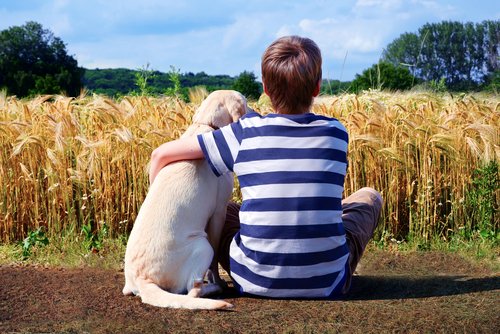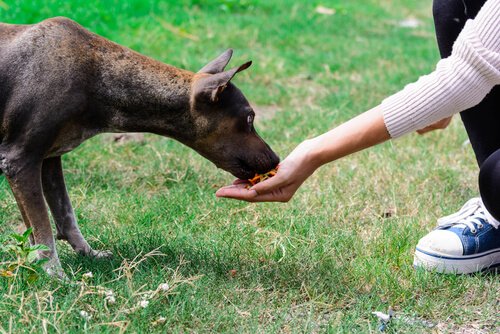Fear of Dogs: What Do I Do If My Child Is Afraid of Dogs?

Many children start shaking if a dog approaches them. It doesn’t matter if it’s a sweet dog, some children fear dogs and they might not even understand why. This can be a problem if this is the child of an animal lover. Their parents might want to encourage them to love dogs. However, the child wants to stay far away from them.
Therefore, this article is to help parents teach their child how to overcome their fear of dogs. However, the first step is really important. You need to find out if your child is scared of dogs or if they have a phobia.
Differences between a phobia and being scared of dogs

Fear is a feeling that is caused by a bad past experience or due to something unknown. When children are small, if they are afraid of dogs from the first time they see one, this is a fear caused by the unknown. If the child used to like dogs and now is scared of them, it’s most likely due to having a bad past experience.
On the other hand, a phobia doesn’t have any logical stimulus or apparent reasons. Sometimes, just from seeing images in photos, magazines, or other media, a child might show their phobia. Phobias can trigger anxiety, altered breathing, and other physical changes. The best way to treat a phobia is to consult with a psychologist.
How can you help your child get over their fear of dogs?
Once you’ve ruled out a phobia, there some steps you can take to help your child get over their fear of dogs.
Don’t force them
People often make the mistake of underestimating their children’s fears, by thinking that they are silly or that they have no reason to feel afraid. This can cause parents to want to force them to do what they want, which, in this case, is approaching a dog. Mistake! Your child is a person with his or her own feeling and emotions. You can’t change them by forcing them. You’ll end up having the opposite effect of the one you’re looking for.
Use placebos
Once you’re certain that your child has a fear of dogs, you can use images or toys to help him/her overcome this fear. This can help your child feel positively towards dogs and, more importantly, attempt to approach dogs in the future.
Show your child pictures of puppies, put together puzzles of dogs, watch movies with dogs in them. Another option is to buy a stuffed dog and teach your child to play with it as if it were a real dog. Little by little, your child may become less afraid.
Show your child that dogs aren’t dangerous
When you are with your child and see a dog, ask the owners if you can pet the dog (and make sure they’re not aggressive). If the owner gives you permission, go up to the dog and pet him while saying nice things to it. Your child will observe this action and see that there isn’t any danger. He/she might even want to try!
Don’t adopt a dog
If your child isn’t prepared, don’t try to bring a dog home, even if you think adopting one will improve the situation. The opposite could happen because it would be like if you were forcing your child to live with their fear. It could create a situation where your child spends a lot of time scared at home. This could create sleep disorders or behavioral issues.
Teach your child how to approach a dog

Teach your child that he/she should approach a dog calmly, let the dog smell his/her hand, and then pet them. Tell your child that the dog may want to lick them or try to climb on f them. Explain that this is because the animal wants to play and there’s no reason to be frightened.
Choose your words carefully
Sometimes people take advantage of their children’s fear to get them to do what they want. For example, “If you don’t eat, a dog will come to eat your food.” Or if they don’t go to sleep, “the dog out front will come and get you.”
Perhaps you’ve even said to a sibling or their parent has told them not to get bitten by a dog. All of this can negatively influence how your child thinks about dogs.
Many children start shaking if a dog approaches them. It doesn’t matter if it’s a sweet dog, some children fear dogs and they might not even understand why. This can be a problem if this is the child of an animal lover. Their parents might want to encourage them to love dogs. However, the child wants to stay far away from them.
Therefore, this article is to help parents teach their child how to overcome their fear of dogs. However, the first step is really important. You need to find out if your child is scared of dogs or if they have a phobia.
Differences between a phobia and being scared of dogs

Fear is a feeling that is caused by a bad past experience or due to something unknown. When children are small, if they are afraid of dogs from the first time they see one, this is a fear caused by the unknown. If the child used to like dogs and now is scared of them, it’s most likely due to having a bad past experience.
On the other hand, a phobia doesn’t have any logical stimulus or apparent reasons. Sometimes, just from seeing images in photos, magazines, or other media, a child might show their phobia. Phobias can trigger anxiety, altered breathing, and other physical changes. The best way to treat a phobia is to consult with a psychologist.
How can you help your child get over their fear of dogs?
Once you’ve ruled out a phobia, there some steps you can take to help your child get over their fear of dogs.
Don’t force them
People often make the mistake of underestimating their children’s fears, by thinking that they are silly or that they have no reason to feel afraid. This can cause parents to want to force them to do what they want, which, in this case, is approaching a dog. Mistake! Your child is a person with his or her own feeling and emotions. You can’t change them by forcing them. You’ll end up having the opposite effect of the one you’re looking for.
Use placebos
Once you’re certain that your child has a fear of dogs, you can use images or toys to help him/her overcome this fear. This can help your child feel positively towards dogs and, more importantly, attempt to approach dogs in the future.
Show your child pictures of puppies, put together puzzles of dogs, watch movies with dogs in them. Another option is to buy a stuffed dog and teach your child to play with it as if it were a real dog. Little by little, your child may become less afraid.
Show your child that dogs aren’t dangerous
When you are with your child and see a dog, ask the owners if you can pet the dog (and make sure they’re not aggressive). If the owner gives you permission, go up to the dog and pet him while saying nice things to it. Your child will observe this action and see that there isn’t any danger. He/she might even want to try!
Don’t adopt a dog
If your child isn’t prepared, don’t try to bring a dog home, even if you think adopting one will improve the situation. The opposite could happen because it would be like if you were forcing your child to live with their fear. It could create a situation where your child spends a lot of time scared at home. This could create sleep disorders or behavioral issues.
Teach your child how to approach a dog

Teach your child that he/she should approach a dog calmly, let the dog smell his/her hand, and then pet them. Tell your child that the dog may want to lick them or try to climb on f them. Explain that this is because the animal wants to play and there’s no reason to be frightened.
Choose your words carefully
Sometimes people take advantage of their children’s fear to get them to do what they want. For example, “If you don’t eat, a dog will come to eat your food.” Or if they don’t go to sleep, “the dog out front will come and get you.”
Perhaps you’ve even said to a sibling or their parent has told them not to get bitten by a dog. All of this can negatively influence how your child thinks about dogs.
This text is provided for informational purposes only and does not replace consultation with a professional. If in doubt, consult your specialist.








